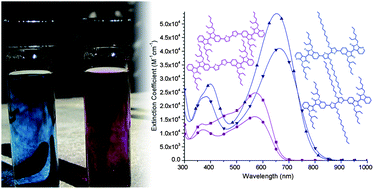7-Azaisoindigo as a new electron deficient component of small molecule chromophores for organic solar cells†
Abstract
The use of 7-azaisoindigo as an electron accepting moiety in donor–acceptor chromophores is reported for the first time. Four chromophores were synthesized that contained either 2,2′-bithiophene or 3,3′-bis(dodecyloxy)-2,2′-bithiophene as an electron-donating sub-unit and either isoindigo or 7-azaisoindigo as an electron acceptor. The inclusion of a heteroatom in the isoindigo framework was designed to probe its effect on the LUMO, while 3,3′-bis(dodecyloxy)-2,2′-bithiophene was used as an electron rich alternative to 2,2′-bithiophene in order to similarly evaluate its effect on the HOMO level. The electronic properties of the resulting chromophores were fully characterized by UV/visible spectroscopy, cyclic voltammetry, and density functional theory. All four dyes were evaluated for their performance as electron donors in bulk heterojunction solar cells using PC61BM as the electron acceptor. Devices that used the isoindigo and 3,3′-bis(dodecyloxy)-2,2′-bithiophene-based dye displayed the best performance, reaching a maximum power conversion efficiency of 0.93%.


 Please wait while we load your content...
Please wait while we load your content...